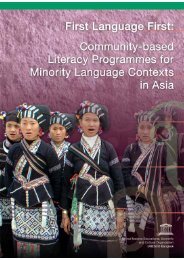Part II.pdf - MTB-MLE Network
Part II.pdf - MTB-MLE Network
Part II.pdf - MTB-MLE Network
You also want an ePaper? Increase the reach of your titles
YUMPU automatically turns print PDFs into web optimized ePapers that Google loves.
Present Status of the Action Research Project<br />
As was mentioned earlier, one pilot school was opened in February 2003 in Agholpur village, which<br />
is now fully operational with 26 students who are now in Class <strong>II</strong>. Second year materials have<br />
been developed for class testing, and these will be reviewed before being finalized. Another pilot<br />
school opened in January 2004 in Edolpur Oraon village, where 35 children are in Class I, learning<br />
in the Sadri language.<br />
10. Challenges of the Project and Possible Solutions<br />
When the project was launched, there were questions regarding the best writing system to select<br />
so that learners could read and write in their mother tongue. The language has no previous alphabet.<br />
Christian missionary attempts at introducing the Roman alphabet proved unsuccessful because it<br />
was not culturally appropriate for the community.<br />
Leaders of the Oraon community came to realize that the Bangla alphabet could be more accessible<br />
and useful for them. The ASHRAI Research Team concurred with their opinion. In order to promote<br />
mass education among the Oraon, the ARP Team devised a method of using the Bangla alphabet<br />
to write the Sadri language so that Sadri speakers could enjoy studies in their mother language.<br />
The development of an appropriate writing system was one of the problems encountered during<br />
materials development.<br />
The Oraon mainly use two colloquial dialects – Sadri and Kuruk. Kuruk has emerged from the<br />
Dravir language group. This language is very complex. Sadri, on the other hand, is a popular<br />
language among the working people of the Oraon community. Sadri is rich with words from the<br />
Bangla, Urdu and Persian languages. Kuruk is purely an indigenous language. Thus, dialect selection<br />
for the development of language materials was a challenge. As Sadri is the most used vernacular<br />
of the Oraon of Northwest part of Bangladesh, the research team selected Sadri.<br />
The teacher from the tribal community who was recruited for our pilot school had no teaching<br />
experience. However, qualified teachers are rarely found in the tribal communities. To overcome<br />
this weakness, we conducted monthly refresher training to enhance her teaching skills.<br />
11. Future Plans<br />
<strong>Part</strong>nerships between various stakeholders<br />
ASHRAI has partnerships with various stakeholders to support indigenous communities through<br />
education and training. We have partnerships with the Swiss Agency for Development and<br />
Cooperation (SDC) in non-formal child and adult education in order to develop the human resources<br />
of indigenous people. In addition, we have also developed partnerships with UNESCO, BRAC<br />
and NETZ (Germany) in non-formal primary education. Finally, we have a plan to work more<br />
closely with ActionAid Bangladesh in adult education. Our partners provide both technical and<br />
financial assistance to improve the standard of non-formal education for indigenous people.<br />
151
















